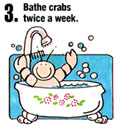Land Hermit Crab Care
How to Care for Your Land Hermit Crab
 |
 |
 |
 |
 |
 |
Hermit crabs in their native environment live near the water and the beach. Their diet consists of leaf litter, fruits and vegetation. They also enjoy chewing and eating bark and have a special preference for decaying wood (except pine or cedar.)
When they have been domesticated it is recommended that they be fed a good commercial food and they may be fed treats such as coconut, romaine lettuce, apple, wheat bread, peanut butter, etc.
Land hermit crabs eat very slowly and very little so all uneaten food should be removed each day to avoid spoilage. Fresh drinking water must be kept in a non-metal container for the crabs at all times, and it is necessary to put an oyster shell or Calcium spa bath in the water for a calcium source.
A clam shell makes a nice water bowl. The water should be shallow (preferably non-chlorinated and low in iron) so the crabs can climb out of the water -- they will drown if submerged for more than a few minutes.
Land hermit crabs should be kept in an aquarium with a 2- to 3-inch base of sand. The temperature should be above 70 degrees and preferably around 85 degrees. This is easy to do if you use a heater under your aquarium and put a wet sponge in the home to supply the needed humidity.
Land hermit crabs do not like a wet, sloppy home. We no not recommend using a FULL SPECTRUM LIGHT OR HEAT LAMPS on the aquarium or the use of corn cob or cedar shavings or gravel instead of sand. They tend to dry out the hermit crabs. It is a good idea to bathe your crabs once a week, as well as giving them an occasional misting OUTSIDE the tank. NEVER attempt to remove a crab from its seashell because it will allow itself to be torn apart rather than give up its protective home.
Hermit crabs are not aggressive like many of the sea crabs and can be handled (they can climb on the outstretched palm of your hand without difficulty), but it is well to avoid the large purple pincher claw which is used for defense and for holding onto limbs for climbing and for balancing. The smaller claw is used to pass food and water to the mouth.
The name "HERMIT" is misapplied for in the wild state, hermit crabs live and travel in colonies of a few dozen to more than 100. It is recommended that in captivity they be kept in the company of other crabs for their own contentment.
They communicate by sound and it is not uncommon to hear them "talking" to each other. They seldom fight except occasionally over a shell dispute. They are clean and odorless and may be released in the home for exercise and for observation of their comical antics if desired. They are good climbers and will enjoy coral or any type of non-resinous wood placed in their aquarium to exercise on.
Like most other creatures, they respond to gentle care and learn to trust their keeper. It is known that some crabs have been kept in the home as pets for as long as 15 years.
Land hermit crabs cannot reproduce in captivity. Their eggs must hatch in the sea. Like other crabs they grow by shedding their outer ex-skeleton. This is the most important step toward growth a small crab will make.
During this time they shed all their skin (which looks like an empty skeleton of a crab.) They need to be kept extra moist and in a medium into which they can burrow themselves. It also may be necessary to isolate the crab for a couple of days because they are very soft, vulnerable and inactive. However, this is an important stage of development for it is in this period that any missing legs, etc., are regenerated by the crabs.
Older crabs molt less frequently but require the same care. As the crabs grow they will need spare shells to grow into and they also seem to enjoy moving into empty shells to select the home that feels best.






